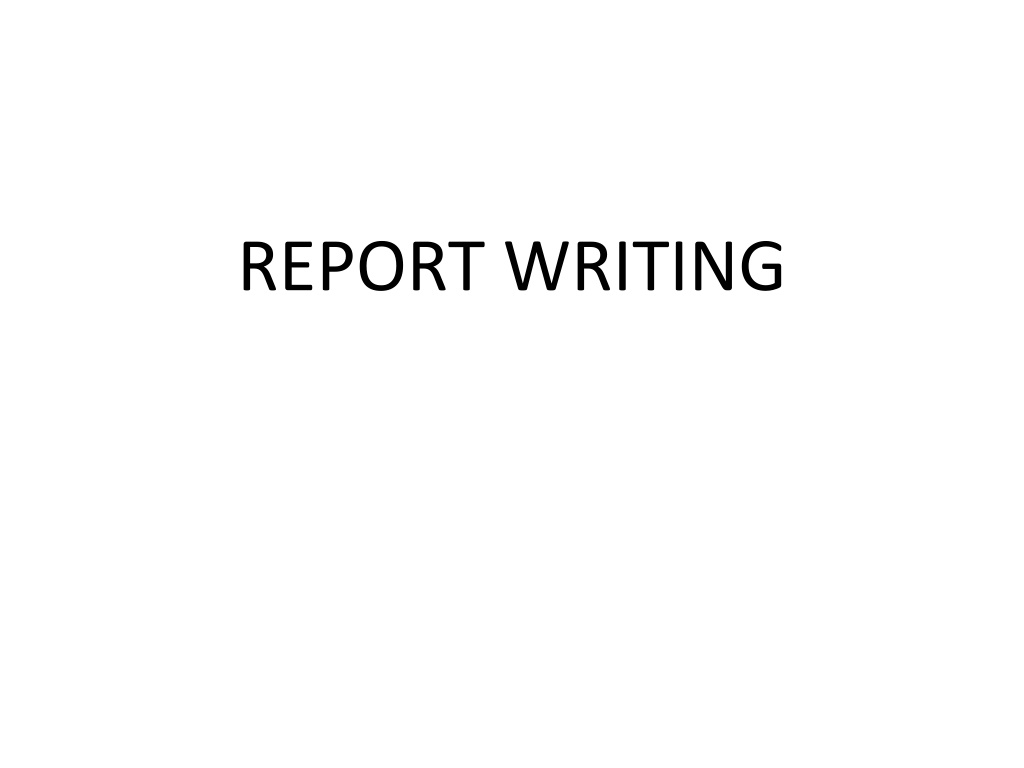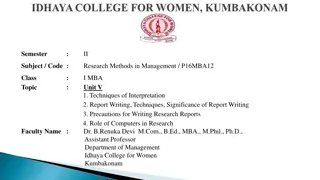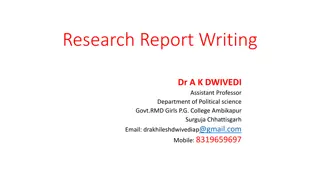Mastering Academic and Research Report Writing
Academic and research report writing is a crucial skill for modern educators. This course covers principles, techniques, and tools for effective dissemination of findings. Learn about the meaning of reports, classification, steps for writing, layout, and mechanics of research reports. Understand the importance of being impartial and the different types of reports - formal, informal, statutory, and non-statutory. Enhance your ability to write reports on academic activities and research effectively.
Download Presentation

Please find below an Image/Link to download the presentation.
The content on the website is provided AS IS for your information and personal use only. It may not be sold, licensed, or shared on other websites without obtaining consent from the author. Download presentation by click this link. If you encounter any issues during the download, it is possible that the publisher has removed the file from their server.
E N D
Presentation Transcript
Academic and research report writing is an essential activity for a contemporary teacher in institutes of higher education. It is a fact that a modern teacher has to play a variety of roles apart from that of an academic instructor. Research is one of such major activities for them. Publication of research findings is an integral part of research. Therefore, it is necessary for a teacher / researcher to learn and apply principles and techniques of report writing for effective dissemination of the academic and research findings. This course intends to introduce the learner to the principles, techniques and tools of academic and research report writing. After successful completion of this course the learner will be able to write reports on various academic activities including research effectively and efficiently.
Contents Meaning of report. Classification of report. Steps for report writing. Layout of the research report. Mechanics of writing a research report.
Meaning of report A report is a presentation of facts and findings, usually as a basis for recommendations; written for a specific readership and probably intended to be kept as a record. It is purely based on observation and analysis. A report gives an explanation of any circumstance/ happenings. A report discusses a particular problem/ solution in detail.
contd.. Reports performances of various departments in an organization. A good report is always fact finding and not fault finding. It should be prepared in an and writers of the report should be impartial in their outlook and approach. are required for judging the impartial manner
Classification 1 Formal 2 Informal 3 Statutory 4 Non-statutory
Contd.. 1 Routine 2 Special 3 Informative 4 Interpretative
Formal and informal Formal Reports: which is prepared presented procedure to a prescribed authority. A formal report is one in a prescribed form and is according to an established Informal Reports: An usually in the form of a communication. It may range from a almost fragmentary statement of facts on a single page or taking several pages. informal person-to-person report is short,
Statutory and Non-Statutory Statutory report: A report prepared and presented according procedure laid down by statutory report. Ex: report etc. to the law is called a report, annual form and audit Non-statutory report: Formal reports which are not required under any law but which are prepared to help the management in framing the policies is called non statutory report. Ex: for policy formulations, Profit statement
Company Logo Routine and Special Periodic prepared and intervals. They semi-annually, weekly or even daily. or Routine presented at regular, prescribed may be submitted annually, quarterly, monthly, Reports: They are fortnightly, Special Reports: They are related to a single occasion or situation or event. Such as technical report of a particular product or policy etc.
Informative and Interpretative Informative Reports: These reports present facts activity in detail without any note or suggestions. Ex: A vice-chancellor asking about appearing at a particular examination. about certain given the number of candidates Interpretative Reports: It analyzes the facts, draws conclusions and makes recommendations. Ex: A company chairman may ask for a report on falling trends in sale in a particular area. He will in this case be interested in knowing all the details including that of any of the investigator. naturally of opinion
Advantage Updated information Solves current problems Discloses unknown information Internal communication Decision making and planning Reliable permanent information
Steps for report writing Research reports are the product of slow, careful, accurate inductive work. The usual steps involved in writing report are: (a) Logical analysis of the subject-matter. (b) Preparation of the outline. (c) Preparation of the rough draft. (d) Rewriting and polishing. (c) Preparation of the final bibliography. (f) Writing the final draft.
A. Logical analysis of the subject matter: It is the first step which is primarily concerned with the development of a subject. There are two ways (a) logically (b) chronologically The logical development is made on the basis of mental connections and associations between the one thing and another by means of analysis. E.g. Cause & effect. Chronological development is based on time or sequence in time.
b. Preparation of the outline: Outlines are the framework upon which long written works are constructed. They are aids to the logical organization of the material and a reminder of the points to be stressed in the report.
c. Preparation of the rough draft: It is utmost importance for the researcher to write down what he has done in the context of his research study and what yet to be done. Collecting the material for study along with various limitations, the technique of analysis adopted, the broad findings and generalizations and the various suggestions wants to offer regarding the problem concerned. Make file too.
d. Rewriting and polishing of the rough draft: This step happens to be most difficult part of all formal writing. Usually this step requires more time than the writing of the rough draft. The careful revision makes the difference between a mediocre and a good piece of writing.
e. Preparation of the final bibliography: The bibliography, which is generally appended to the research report, is a list of books/journals in some way pertinent to the research. The bibliography should be arranged alphabetically and may be divided into two parts: 1. First part- contain the names of books and pamphlets 2. Second part- contain the names of journals, magazine and newspaper articles.
For books and pamphlets the order may be as under: 1. Name of author, last name first. 2. Title, underlined to indicate italics. 3. Place, publisher, and date of publication. 4. Number of volumes. Example David, C.R., Quantitative Techniques, Pearson Publishing House Pvt. Ltd., New Delhi 2018. Edition II.
For magazines, journals and newspapers the order may be as under: 1. Name of the author, last name first. 2. Title of article, in quotation marks. 3. Name of periodical, underlined to indicate italics. 4. The volume or volume and number. 5. The date of the issue. 6. The pagination. Example Robert V. Roosa, Coping with Short-term International Money Flows , The Banker, London, Vol. 5, Issue II, September, 2018, p. 995.
f. Writing the final draft: This constitutes the last step. The final draft should be written in a concise and objective style and in simple language, avoiding vague expressions such as itseems , there may be , and the like ones. While writing the final draft, the researcher must avoid abstract terminology and technical jargon. Illustrations and examples based on common experiences must be incorporated in the final draft.
LAYOUT OF THE RESEARCH REPORT A comprehensive layout of the research report should comprise of: (A) Preliminary pages (B) The main text (C) The end matter.
(A) Preliminary Pages In its preliminary pages the report should carry a title and date, followed by acknowledgements in the form of Preface or Foreword . Then there should be a table of contents followed by list of tables and illustrations so that the decision- maker or anybody interested in reading the report can easily locate the required information in the report.
(B) Main Text The main text provides the complete outline of the research report along with all details. Title of the research study is repeated at the top of the first page of the main text and then follows the other details on pages numbered consecutively, beginning with the second page. The main text sections: (i) Introduction, ROL, RM (ii) Statement of findings and recommendations (iii) The results (iv) The implications drawn from the results (v) The summary.
(i) Introduction: The purpose of introduction is to introduce the research project to the readers. It should contain a clear statement of the objectives of research i.e., enough background should be given to make clear to the reader why the problem was considered worth investigating. Scope limitations
(ii) Statement of findings and recommendations: After introduction, the research report must contain a statement of findings and recommendations in non-technical language so that it can be easily understood by all concerned. If the findings happen to be extensive, at this point they should be put in the summarized form.
(iii) Results: A detailed presentation of the findings of the study, with supporting data in the form of tables and charts together with a validation of results, is the next step in writing the main text of the report. This generally comprises the main body of the report, extending over several chapters. Statistical summaries. The conclusions at which he arrived, and the bases for his conclusions
(iv) Implications of the results: Implications may have three aspects as stated below: (a) A statement of the inferences drawn from the present study which may be expected to apply in similar circumstances. (b) The conditions of the present study which may limit the extent of legitimate generalizations of the inferences drawn from the study. (c) The relevant questions that still remain unanswered or new questions raised by the study along with suggestions for the kind of research that would provide answers for them. E.g. If present conf. paper first time better to put some limitations.
(v) Summary: It has become customary to conclude the research report with a very brief summary, resting in brief the research problem, the methodology, the major findings and the major conclusions drawn from the research results.
(C) End Matter At the end of the report, appendices should be enlisted in respect of all technical data such as questionnaires, sample mathematical derivations and the like ones. Bibliography of sources consulted should also be given. Index (an alphabetical listing of names, places and topics along with the numbers of the pages in a book or report on which they are mentioned or discussed) should invariably be given at the end of the report. information,
Company Logo Format For short report 1. Title 2. Introduction 3. Data Analysis 4. Summary and conclusions 5. Recommendations 6. (appendix)
Company Logo Contd.. For long reports: 1. Title or title page 2. (contents list ) 3. (abstract ) 4. Introduction 5. Data Analysis & Discussion 6. Summary and conclusions 7. Recommendations 8. (appendix)
MECHANICS OF WRITING A RESEARCH REPORT There are very definite and set rules which should be followed in the actual preparation of the research report or paper. 1. Size and physical design 2. Procedure 3. Layout 4. Treatment of quotations 5. The footnotes 6. Punctuation and abbreviations 7. Use of statistics, charts and graphs 8. The final draft 9. Preparation of the index
1. Size and physical design Written on un-ruled paper 8 1 /2 11 in size. Margin-one and one-half inches should be allowed at the left hand and of at least half an inch at the right hand of the paper. There should also be one-inch margins, top and bottom. Typing should be double-spaced on one side of the page only.
2. Procedure Various steps in writing the report should be strictly adhered ( studied back)
3. Layout Keeping in view the objective and nature of the problem, the layout of the report should be thought of and decided accordingly. (types of reports).
4. Treatment of quotations Quotations should be placed in quotation marks and double spaced, forming an immediate part of the text and indented at least half an inch to the right of the normal text margin.
5. The footnotes Footnotes are meant for cross references, citation of authorities and sources, acknowledgement and elucidation or explanation of a point of view. Footnotes are placed at the bottom of the page. Footnotes should be numbered consecutively or mark asterisk (*).
6. Punctuation and abbreviations anon., ante., art., aug., bk., bull., cf., ch., col., diss., ed., ed. cit., e.g., eng., et.al., anonymous before article augmented book bulletin compare chapter column dissertation editor, edition, edited. edition cited exempli gratia: for example enlarged and others
Contd et seq., ex., f., ff., fig(s)., fn., ibid., more successive footnotes refer to the same work, it is not necessary to repeat complete reference for the second footnote. Ibid. may be used). id., idem: the same ill., illus., illustrated, illustration(s) et sequens: and the following example and the following figure(s) footnote ibidem: in the same place (when two or
n.d., n.p., no pub., no(s)., o.p., p. or pp., passim: post: rev., tr., trans., vid or vide: viz., vol. or vol(s)., vs., versus: no date no place no publisher number(s) out of print page(s) here and there after revised translator, translated, translation see, refer to namely volume(s) against
7. Use of statistics, charts and graphs Good picture is often worth more than a thousand words. Statistics are usually presented in the form of tables, charts, bars and line-graphs and pictograms. Such presentation should be self explanatory and complete in itself. Statistical presentation should be neat and attractive.
8. The final draft Are the sentences written in the report clear? Are they grammatically correct? Do they say what is meant? Do the various points incorporated in the report fit together logically?
9.Preparation of the index An index should invariably be given, the value of which lies in the fact that it acts as a good guide, to the reader. Arranged alphabetically.























